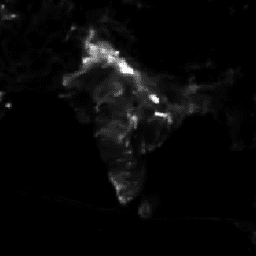
- 데이터 세트 제공
- 2018-01-01T00:00:00Z–2025-10-16T12:00:00Z
- 데이터 세트 제공업체
- NASA / GMAO
- 태그
설명
이 데이터 세트에는 시간적 빈도가 높은 데이터 (htf)의 기상학적 재생 (rpl)이 포함되어 있습니다. Goddard Earth Observing System Composition Forecast (GEOS-CF) 시스템은 NASA의 Global Modeling and Assimilation Office (GMAO)에서 제공하는 고해상도(0.25°) 전역 구성요소 예측 시스템입니다.
GEOS-CF는 NASA의 광범위한 우주 기반 및 현장 관측을 보완하기 위해 대기 화학 연구를 위한 새로운 도구를 제공합니다. GEOS-CF는 GEOS-Chem 화학 모듈을 도입하여 GEOS 날씨 및 에어로졸 모델링 시스템을 확장하여 오존 (O3), 일산화탄소 (CO), 이산화질소(NO2), 이산화황 (SO2), 미세먼지 (PM2.5)를 비롯한 대기 성분의 과거 예측 및 5일 예측을 제공합니다. GEOS-CF에 통합된 화학 모듈은 오프라인 GEOS-Chem 모델과 동일하며 GEOS-Chem 커뮤니티에서 제공하는 혁신을 즉시 활용할 수 있습니다.
2018~2019년의 위성, 오존존데, 지표 관측에 대한 GEOS-CF 평가에 따르면 O3, NO2, CO의 시뮬레이션된 농도가 현실적이며, 정규화된 평균 편향은 -0.1~0.3, 정규화된 평균 제곱근 오차는 0.1~0.4, 상관관계는 0.3~0.8입니다. 지표 관측과의 비교를 통해 전 세계 여러 지역과 모든 계절에 걸쳐 대기 오염 물질이 성공적으로 표현되었음을 알 수 있지만, SO2의 전 세계적인 높은 편향과 미국 남동부의 여름철 O3 과다 예측과 같은 현재의 한계도 알 수 있습니다.
GEOS-CF v1.0은 GEOS-Chem v12.0.1의 알려진 문제로 인해 일반적으로 에어로졸을 20~50% 과대평가하며, 이 문제는 이후 버전에서 해결되었습니다. 5일 예측의 기술 점수는 1일 예측과 비슷합니다. 머신러닝 접근 방식을 사용하여 표면 모델 출력에 편향 보정을 적용하면 모델 기술을 크게 개선할 수 있습니다.
대역
픽셀 크기
27,750미터
대역
| 이름 | 단위 | 픽셀 크기 | 설명 |
|---|---|---|---|
CO |
몰 분율 | 미터 | 일산화탄소 (CO, MW = 28.00g mol-1) 건조 공기 부피 혼합 비율 |
NO2 |
몰 분율 | 미터 | 이산화질소 (NO2, MW = 46.00g mol-1) 부피 혼합 비율 건조 공기 |
O3 |
몰 분율 | 미터 | 오존 (O3, MW = 48.00g mol-1) 부피 혼합 비율 건조 공기 |
PM25_RH35_GCC |
ug m-3 | 미터 | 직경이 2.5μm 미만인 미세먼지 RH 35 |
PM25_RH35_GOCART |
kg/m^3 | 미터 | Total reconstructed PM2.5 RH 35(총 재구성된 PM2.5 RH 35) |
Q |
질량 분율 | 미터 | 비습 |
RH |
미터 | 습윤 후 상대 습도 |
|
SLP |
Pa | 미터 | 해면 기압 |
SO2 |
몰 분율 | 미터 | 이산화황 (SO2, MW = 64.00g mol-1) 부피 혼합 비율 건조 공기 |
T |
K | 미터 | 기온 |
U |
m/s | 미터 | 동쪽으로 부는 바람 |
V |
m/s | 미터 | 북풍 |
이용약관
이용약관
달리 명시되지 않는 한 NASA에서 제작한 모든 데이터는 사전 허가 없이 어떤 목적으로든 사용할 수 있습니다. 자세한 내용과 예외는 NASA 데이터 및 정보 정책 페이지를 참고하세요.
인용
Keller, C. A., Knowland, K. E., Duncan, B. N., Liu, J., Anderson, D. C., Das, S., ... & Pawson, S. (2021). NASA GEOS 구성 예측 모델링 시스템 GEOS-CF v1에 대한 설명입니다. 0. Journal of Advances in Modeling Earth Systems, 13(4), e2020MS002413. doi:10.1029/2020MS002413
DOI
Earth Engine으로 탐색
코드 편집기(JavaScript)
var imageVisParamNO2 = { 'bands': ['NO2'], 'min': 6.96e-11, 'max': 4.42e-8, }; var imageVisParamT = { 'bands': ['T'], 'min': 220, 'max': 320, 'palette': ['d7191c', 'fdae61', 'ffffbf', 'abd9e9', '2c7bb6'], }; var geosCf = ee.ImageCollection('NASA/GEOS-CF/v1/rpl/htf'); Map.setCenter(100, 20, 3); var weeklyT = geosCf.select('T').filterDate('2019-06-01', '2019-06-08').median(); Map.addLayer(weeklyT, imageVisParamT, 'Weekly T', false, 1); var NO2 = ee.Image('NASA/GEOS-CF/v1/rpl/htf/20190601_0000z'); Map.addLayer(NO2, imageVisParamNO2, 'NO2', true, 1);
